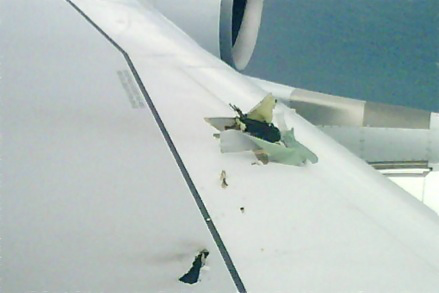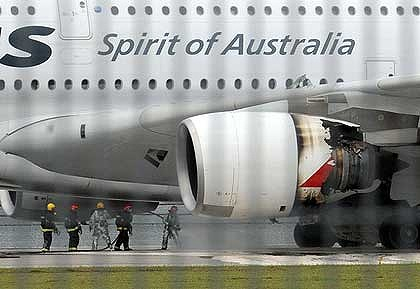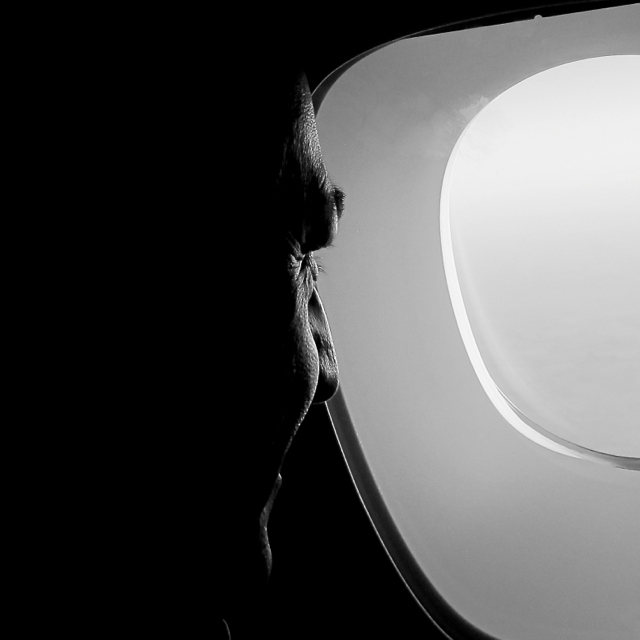QANTAS A380

This pic, from the upper deck, was taken by passenger: Christopher Lee.
A380 Engine Failure After Takeoff
The Twitter-world went crazy with reports of a QF crash into an Indonesian island. Reports were dispelled after a very tense hour. I had just flown the Emirates A380 from Sydney to Dubai, and had just arrived at my home when the first reports came in.
QF32 was headed from Singapore to Sydney and suffered a failure of engine No.2 six minutes after takeoff. Pieces of the rear engine cowling were recovered from nearby Batam island, a resort frequented by Singaporeans.
The aircraft can easily fly with one engine-out, and even without two. Pilots are tested for this every six months, the manoeuvre is not even stressful —even when the simulator examiner adds massive vibration and even a fire. Engine failure on takeoff is probably the most-tested item.

Photo : AFP from The Age website
Photos of the parked Qantas aircraft, after returning uneventfully to Singapore, show that the engine’s huge front fan was contained —as designed.
See how the engines are tested in this remarkable video:
[ http://www.youtube.com/watch?v=zWzg8w-0TBI ]
BBCworld TV shows firemen hosing foam into the No.1 engine, to flame out the engine as it could not be shut down by the crew.
Heavy braking on an overweight airliner may cause the tyres to deflate as fuse plugs in wheels melt from excessive brake heat —otherwise they could explode. Dousing the brakes with a water-foam mix prevents them from catching fire.
It turns out that the aircraft was substantially crippled, with the crew handling 52 separate procedures, according to press reports.
One hydraulic system was out, requiring the crew to manually lower the 27 tonne landing gear by gravity extension.
The A380 is the first airliner to have backup electrically-powered flight control systems, so everything operated normally, except the front wing slats —so the landing speed would have been a few knots faster than normal.
An unnamed passenger reports that the Captain said fuel was leaking from the dead engine once it parked. ‘The landing was perfect!’ he said.
There were three Pilots operating the sector: a Captain, a First-Officer and Second Officer. They were being Observed by two Check and Training Captains.
Passenger Lars Sandberg told BBCworld that they dumped-fuel and that the Captain was doing PAs ‘every five minutes’ —instilling calm and confidence in the passengers. He was mistaken. The 'dumped fuel' was actually fuel leaking from the #2 feed tank.
When they deplaned there was a smell of spilt jet fuel.
Another passenger, Christopher Lee took a photo (above) showing holes in the number two slat at the front of the wing. He gave a wide ranging interview to ABC PM, listen to it here:
http://www.abc.net.au/pm/content/2010/s3057400.htm#extras
Those of you concerned by flying and aviation technology should be amazed by how often everything works as designed, thanks to the perfectionism and professionalism of the engineers, for whom the flight crews offer their undying thanks and admiration. Think about that next time your flight is delayed due to a technical problem.
Qantas and Singapore use the Rolls Royce engines made in the U.K. Emirates A380s use EA (Engine Alliance) engines made in the U.S.A.
Qantas has now grounded their six A380s from takeoffs until engineering data is examined.
This is an engine manufacturer problem, not an airframe one, caused by the failure of a second stage compressor blade.
The A380 (airframe) is still safe to fly, indeed, this incident shows just how well the aircraft performed. Singapore Airlines is continuing to fly their 12 Rolls-powered A380s.
Nov. 6th., 2010
